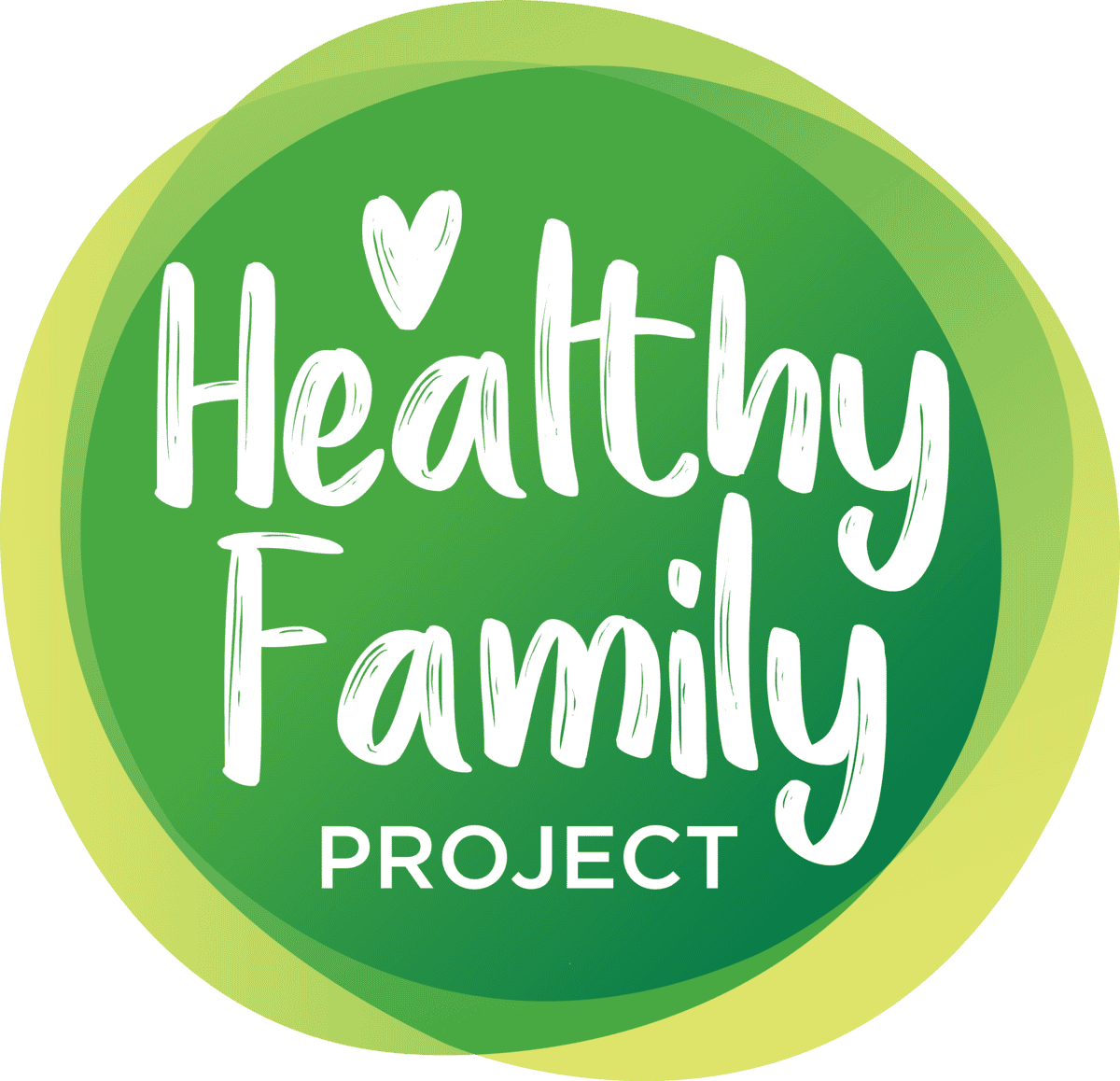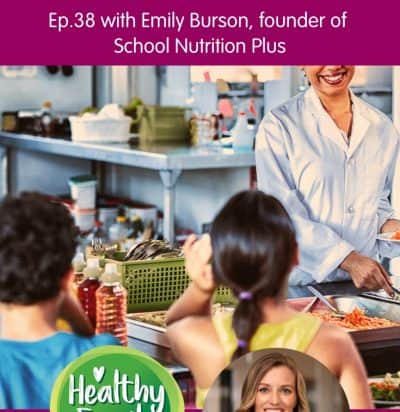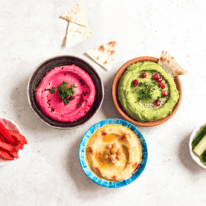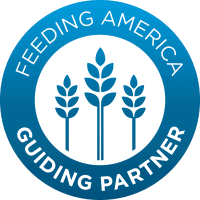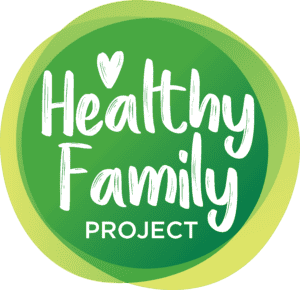Episode 38: Healthy Choices in the School Lunchroom
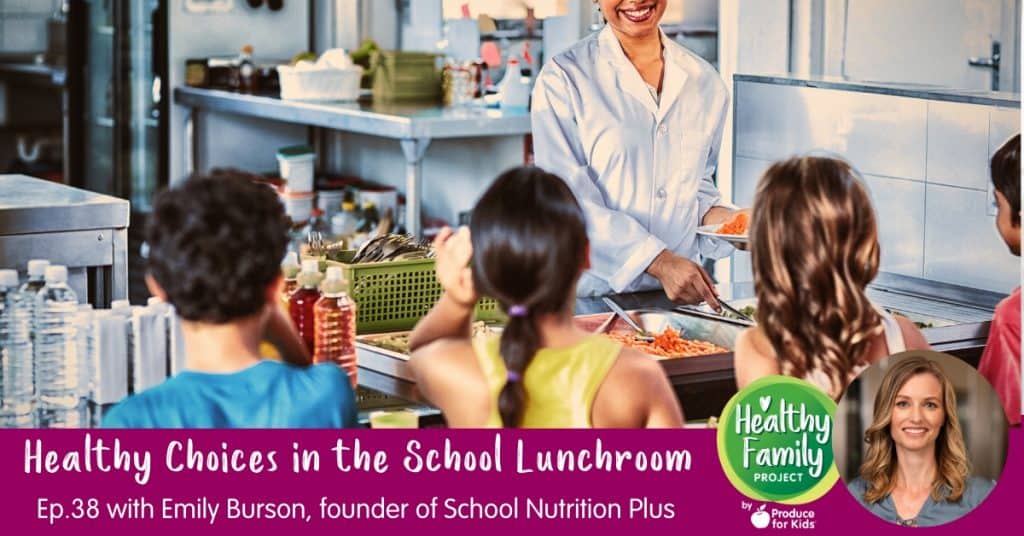
In this episode of Healthy Family Project, we talk to Emily Burson, a registered dietitian and founder & CEO of School Nutrition Plus, all about how parents can help their children make healthier choices in the lunchroom.
Emily shares tips on how parents can encourage kids to make healthy choices in lunch line and educate them about the importance of nutrition and overall health as well as how parents can advocate for healthy choices in the lunchroom.
School Nutrition Plus is a full-service caterer that specializes in the unique needs of charter schools. Their chefs prepare nutritious and appetizing meals, all from scratch, that get kids to not only eat their veggies but love them.
Emily oversees the overall direction of SNP, utilizing her broad knowledge of nutrition and experience in the food service industry. Before founding the company, she served as a food service consultant for Consulting Nutritional Services, taught Nutrition and Foodservice at Pepperdine University and managed charter school accounts in Southern California for Sodexo School Services.
Emily is also the author of the A Chef Walks Into a Cafeteria cookbook, which honors the flavor values of scratch cooking and will inspire families to cook together, with recipes actually served in the school cafeteria!
Listener Survey!
Thank you so much for supporting the Healthy Family Project Podcast! We’d love it if you could take 5 minutes to let us know how we can bring you the best possible content for future episodes. Take the survey here.
Healthy Recipes & Tips in Your Inbox
Sign up for the Healthy Family Project e-newsletter to receive healthy recipe inspiration, our latest blog posts and more directly to your inbox each week.
Healthy Family Project Facebook Group
Join our Healthy Family Project Facebook group! This group will serve as a safe space for parents and caregivers to talk all about raising a healthy family – from dealing with a picky eater and tips to get more fruits and veggies onto plates to exercising as a family and mental health. We welcome all of you to join in!
Want to skip straight to a hot topic? See time stamps below. But of course, we recommend listening all the way through!
- 2:40 School Nutrition Plus intro
- 6:55 How can parents encourage kids to make healthy lunch choices
- 9:40 Ways parents can advocate for lunchroom changes in schools
- 12:48 How to sway kids to make better choices without shaming them
- 16:10 Recipe inspiration for the foods Emily makes in schools
- 19:25 A Chef Walks into a Cafeteria – scratch cook recipes
- 25:10 What does a healthy family mean to you?
Relevant Links
- How to Make Healthy Choices in the Lunch Line
- 10 Back to School Meal Planning Tips
- Back to School Recipes & Tips
- Connect with Emily on Facebook and Instagram
- School Nutrition Plus
- A Chef Walks into a Cafeteria cookbook
- Catch up on Food Rx!
Other Podcast Episodes to Check Out:
- Episode 35: Helping Kids Make Good Choices
- Episode 34: Lunchbox Packing Mistakes to Avoid
- Episode 33: Thinking Outside the Lunchbox Rut
- Episode 7: Lunchbox Meal Prep
Healthy Family Project Podcast
Conversations covering hot topics in the world of health, food and family with a dose of fun. Helping families ease their way into a new fresh and healthy world.
Be on the lookout for new bi-weekly episodes and don’t forget to subscribe on Apple Podcasts, Google Podcasts, Spotify or your favorite podcasting site. If you like an episode, make sure to leave a rating and comment.
If you are interested in being a guest on the Healthy Family Project podcast, contact amanda@healthyfamilyproject.com with your topic idea for consideration.
Transcript for Episode 38
This transcript was produced by Otter.Ai. Please forgive any misspellings and grammatical errors.
00:14
Welcome to the healthy family project by produce for kids, covering the hot topics in the world of health,
food and family with a dose of fun. We’ve been talking a lot about packing lunches during this back to
school season. But I do realize that not all of our kids take their lunches to school. In fact, in the US,
hundreds of 1000s of kids buy lunch every day. So it’s really important that we help these kids to make
good choices in the lunch line and also be involved in our schools to make sure they’re being provided
with the most nutritious options in the lunchroom. So I wanted to take some time today to talk to an
expert who has lived her life in the food school system and get a few tips for those of us that are buying
lunch. Today we’re talking to Emily Burson, a registered dietician and founder and CEO of school
nutrition plus school nutrition Plus is a full service caterer that specializes in the unique needs of charter
schools. Their chefs prepare nutritious and appetizing meals all from scratch that get kids to not only eat
their veggies but love them. Emily oversees the overall direction at school nutrition plus, utilizing her
broad knowledge of nutrition and experience in the foodservice industry. before founding the company.
She served as a food service consultant for consulting nutritional services, taught nutrition and food
service at Pepperdine University, and manage charter school accounts in Southern California for Sodexo
school services. Emily is also the author of a chef walks into a cafeteria cookbook, which honors the
flavor values of scratch cooking, and we’ll inspire families to cook together with recipes actually served in
the school cafeteria. Really cool. Bring that all full circle. So like I said, we have been talking a lot about
how to pack a healthy lunchbox. Now we’re gonna flip the script a little bit and talk about the lunches that
our kids are buying at school. I’m excited about this conversation today. So let’s get started with Emily.
Welcome, Emily. We’re so excited to chat with you today on the healthy family project. It’s back to school
time. Yay. So it’s definitely back to school time. And we know you spend your time in schools making
sure students have nutritious meals to keep them powered through the day. Some of our listeners might
know you from past Instagram takeovers, but can you tell us a little about you and your company school
nutrition plus?
02:41
Sure. Thanks for having me back. Today is one of our busiest days as well. It’s one of our I would say 15
first days of school, wow. Work with about 50 schools and they all obviously don’t start on the same day.
Thank God. So a lot of first days for us. We’re in our 11th year with school nutrition plus and my
background is as a registered dietician. When I got out of school, I knew that I wanted to work in food
service management, I love working with food and I love managing teams and working towards a
common goal associated with health. So school food service is really the perfect fit for me. I started out
by working for Sodexo, which is a large food service management company. And it was a great training
ground for me for four years working in large K through 12 districts. And this was about the time when
charter schools came on the scene. And 11 to 15 years ago when the first charter school started up in
California. And we saw an opportunity there and I’d say we my business partner Brandon is a chef. He
and I both worked for Sodexo. So we started school nutrition plus to serve this underserved community.
Our former employer didn’t really have a boutique approach to school food service management and we
at SMP do because our clients while a charter school is considered its own school district. They are a lot
smaller than k through 12 schools and they all need an individualized, customized approach to their
menu in their program. And we started out by cooking in schools kitchens, the first charter schools were
founded on school campuses, and they had access to the cafeteria, the school’s cafeterias you could
cook in the kitchen. But as the charter schools increase the number, there aren’t enough sites. So these
days they’re in office buildings, trailers, they co locate with school districts, meaning they share site with
the school district and sometimes don’t have access to the kitchen. So now we’re serving meals, on in
the hallways, in janitors, closets, out in the open really wherever there’s room to serve the kids. We have
100 employees and we serve meals throughout Los Angeles, in Orange County, in our signature
services, scratch cooked meals, most of our schools or low income students are on the free reduced
lunch program. So we try to bring them the healthiest food possible. To us. That means cooking from raw
ingredients and presenting a meal that looks like food versus something that’s in a package. I use the
example of you ask a student, what what their favorite chicken dishes, and the younger ones will say,
well, chicken nuggets, chicken 10 said, but know what part of a chicken, what kind of chicken is your
favorite. And they just look at me with a blank stare. So we are the ones that are introducing chicken legs
to them chicken drumsticks, that sort of thing real what real food is. And that really drives me to keep
putting this food in front of students. So they grow up with healthy habits.
05:55
Well, that’s wonderful. We certainly hear it produce for kids admire everything that you do, and your
organization does. And we applaud your passion and in your impact the impact you’re really making and
you know, the creating a healthier generation, which is was what we’re all about, and what we know
you’re all about to so awesome stuff there. So we know a lot of kids eat school lunch. So while we’re
talking a lot about lunchboxes, we definitely want to address, you know the large part of our population
that does eat lunch at school, what are some ways parents can help encourage their kids to make
healthier choices choices in the lunch line when the parents aren’t there kind of overseeing what they’re
putting on their plate.
06:39
Having some sort of routine at home, that involves eating a fruit or vegetable with every meal and snack
makes it easier for these habits to translate to school. Obviously, when kids get to school, they’re going
to be influenced by their friends, and will probably not eat as healthy as right. But establishing this
mentality and a meal pattern. Especially when students are young and kids are young. Most kids eating
habits and palates are established before the age of five. So if a food isn’t introduced to a child, before
the age of five, it’s not likely they’re going to want to try it until they’re in their 20s. So introducing kids to
as many foods as possible is one tip. And also just drilling in with every meal or snack, have a fruit or
vegetable variety, it doesn’t matter what it is, it’s about that pattern. And rather than try to teach about
calories, or portion sizes, that’s too big of a concept for how to get at this point. It’s just simply pick a fruit
or vegetable.
07:48
Yeah, I like that. And I’ve been doing that with my younger daughter, you know, we’ll get to a point in the
day and both of my girls now like they’re not with me all the time. So even if it’s not a school day, they
might be you know, on a play date, or my older daughter’s at a friend’s house doing whatever. And so I’ll
say whenever they say, Oh Mom, can I have some ice cream? Or can I have whatever it might be? I say
how many fruits and vegetables have you had so far today? And it just causes them to like, stop and
think for a second like, oh, wow, I didn’t invite younger Bumble say, Alright, can I have some carrots and
then have the ice cream? Okay. Yeah, but I just like that you stopped and thought about it. So. So that’s,
that’s really good advice of making sure that and I like the kind of simplifying it and just saying, what was
the fruit or vegetable you added instead of how much or the portion or the calories or things like that
good tips. So I had a chance to look at the list of schools your company serves. So which is awesome,
but what if you have a child attending a school where the lunches provided aren’t the healthiest? How do
you recommend parents go about raising the issue with their school? I know you work with charter
schools, public schools could be a little different. There’s so many different types of schools out there, but
I’m just wondering if you had some tips kind of on a first step for advocating change within a school?
09:16
Sure. I personally have worked with K through 12 districts charter schools, we have a private school
account in Taiwan. That’s interesting. I’ll address K through 12, and charters. First, the public school
sector. All schools are required to have school wellness committees. These committees are made up of
parents, students, nurses, teachers, food service director, administrators and anybody else in the school
community interested in food, it’s mandatory. So I would say first of all, find out about the wellness
committee and how to get on it. And the PTA is also a good organization and at some point, the PTA is
going to be interested in school food I was working at K through 12 districts in LA 15 years ago was CIT
Expo and out of the blue, we were presented with a five inch binder that the PTA put together with
suggested changes for the lunch program without our knowledge. And parents are just as much
stakeholders in the lunch program as students are. And as a food service director, I had to pay attention.
So that’s that’s one tip is get in front of the food service director. And they’ll listen to you, you know, part
of their job to weigh parent input and planning menus. With private schools, there’s a little bit more
flexibility in the meal program, because you’re not following federal guidelines, right. And there’s usually
a little bit more of a budget for the food service department. So it’s easier to make changes with private
schools, but it like I said, PTA, these mandatory wellness committees are the way to get in and get your
voice heard in the schools.
10:58
Okay, those are a great ideas, I wasn’t aware that every school would, you know, was required to have
that school wellness committee. So I think that that’s really interesting information. Because I know, I
hear all the time we hear from people well, I just don’t know where to start, you know, like, I know that I
have, I there are changes to be made. But I don’t know where to start. So I think those are, that’s good
information on, on getting people headed in the right direction. So my daughter’s school account. So as I
mentioned that my kids pack lunches, but on my older daughter, she’ll buy lunch on Fridays, because
they have pizza. And that’s something I did growing up. So we kind of did the same thing with her Plus, it
gives us a break. We don’t have to pack lunches on Fridays. So that’s always a plus. But you know,
looking at her account, it shows me everything she buys on there. And I’ve seen here and there, you
know, a brownie or things, you know, kind of those things that she has her own lunch or she’s adding on
or she says, Oh, well, I bought so and so something, you know, I just keep that account for so just even
in case if she forgets her lunch, she can go in and buy something. So how can parents tackle the difficult
conversation if they’re seeing kids purchasing unhealthy foods, you know, to encourage them to make
healthier choices without causing shame or guilt.
12:22
I think that teaching kids about nutrition and making healthy choices should be prioritized as high as
other skills that are taught and developed at home like type one shoes, for example, learning how to take
a shower, how to get dressed, even to how to get along with your sibling, or how to deal with difficult
people at school. It’s a life skill. And it’s not treated as such. It’s not treated as such at home or in schools
right now. So it’s really a place where there’s room for improvement. I mean, think about how important
food and diet is in a person’s health, especially as they get older. So my number one, number one advice
is to start educating children about physical activity, and eating healthy at home every day and treat it just
like you would teaching them how to be an adult. Really, when you think about it, it’s incredibly important
and will shape the rest of their life, their health. And I just I understand that there are challenges when it
comes to affording healthy food sometimes, but even if it’s just as a family deciding you’re going to go on
a hike once a week. Right, then you’re teaching your child well, you know, you need to work exercise or
fitness or movement into your routine. So it’s a responsibility that parents have. And I think it’s a
responsibility that schools have also right now nutrition isn’t taught as much as it should in schools, that
kids get a little bit in elementary school and then in some high school science, but it really needs to be
prioritized higher.
14:05
I agree with that. I you know, I guess we talked so much on this podcast about how to be healthy and
and I feel like the schools, you know, that is something definitely that’s missing. That could be you know,
I think I have lots of I feel like life skills that might be missing from the school system that aren’t being
taught. But But nutrition, I think, yeah, definitely something that that we should be incorporating with kids.
14:37
As an employer, with 100 employees, I have employees who are in their 40s 50s 60s down to 20s. And
when some of my employees start getting getting into their 40s I see them getting health problems and it
affects their work and how much they’re able to come to work and how much they call out. And it’s
because they’re not leading a healthy life. So it affects adult productivity, society’s productivity so much
as people get older. And if we can appreciate that, then hopefully, we can, like I said, prioritize healthy,
younger and instilling these habits and people.
15:20
Agree agree for sure. So we’re always so jealous seeing what you’re cooking up in schools, everything
looks so delicious. So where do you find the inspiration for the recipes you create in schools? And do
you have any advice for parents who want to replicate some of those at home,
15:37
or recipes are partially driven by inspiration partially by necessity, you know, I’ll give you an example of
both versus necessity. Lunchtime is so short, these days, the kids have a half an hour to stand in line and
eat their lunch. And at lower income schools, you have up to 99% of the students eating. So you need to
move through the line fast. And we’re talking 500 to 1000 kids trying to get through a lunch. So what
we’re doing is we daily now are menu and grab and go salad sandwiches and wraps. And they’re healthy
choices, but they’re quick, so they get the line moving faster. And we’ve been working on some new
recipes to develop that we used to just do that twice a week. Now we’re doing it every day. And we’re
also driven by needing to have more plant based choices on the menu. And we do not have the budget
for the fake meats, the processed meats Beyond Meat, that sort of thing. So I don’t believe that that is
the solution, or necessarily healthy just because the amount of processing that goes into those. The I’ll
just call the fake meats, right, I you know, they contain coconut oil and other ingredients. And we would
rather menu beans instead, or tofu. So that’s what we do. We’re working on some vegetarian items. As
far as inspiration goes. This year, we’ve been working with the North harvest bean Growers Association.
And we’ve been given the opportunity to take their inventory of beans, which is 10 types of beans and
create some recipes from them. And that’s really fun, because they have some alternative beans that
you don’t normally see in a school menu, like maybe beans are white kidney beans, right, created a
sweet potato, kidney bean chili, a chicken chili viraday with white beans and a black bean hummus. And
we’re rotating those throughout our menu. And they’re really well received and great flavor profiles. And
it’s nice to switch up the protein, the vegetarian protein in the past it’s cheese a lot of the time because
that’s what the government provides schools for free. And like I said before, we prefer to use the truly
plant based proteins in vegetarian meals. One instance of I guess, necessity is when we were working
with the school in Taiwan, we had to get creative. We put a pesto on their menu, and they had asked us
to do some training with their chefs on Western items. So we thought well, we’ll replicate the pesto pasta
recipe in our cookbook, but they don’t have access to pine nuts over there. Nor do they have access to
traditional basil. So we ended up using a Chinese spinach and our seeds. Sunflower seeds are abundant
over there who knew it tasted amazing. And it was a really fun challenge for us. So as far as advice for
parents at home, there’s a lot more scratch cooking happening in schools these days. And but like I said
before, when I touched on the chicken nuggets, if students aren’t exposed to what real food looks like,
they’re going to be afraid of it or less likely to try it at school. We wrote a cookbook called a chef walks
into a cafeteria and it’s our scratch cook recipes scaled down for home use. And purpose is to expose
kids and families to ingredients in their raw state and whole recipes, whole foods so that when students
come to school, see it in the lunch line, they’re more likely to try it or at least recognize what it is. So I
would say number one is involve your kids and cooking because it’s likely that they’re going to want to
taste it if they tried her hand in hand and making it also include them in grocery shopping. That’s fun.
Take them to the grocery store. Let’s pick a fruit or vegetable and then build a recipe around it. Google a
recipe so really involve them and then they become invested in the final product and like I said are more
likely to try it. The more attention you pay to kids and students, the more likely they are to try foods and
we like I said work with schools that serve a lot of students at one time and there isn’t a lot of supervision
or people around but When we and school staff have the time to sit down and eat with the kids, or even
just ask them, Did you try this? Do you like this, they’re more likely to try it.
20:09
Right. And I always say my younger daughter, she’s, she’s my selective eater. She’s not picky, she’s
selective, but she, she can call out any fruit or vegetable, we go through the produce department
department, and she can name it all. She won’t eat it all. But I have hope that because I, you know, I’m
trying to cut myself a little slack. And you know, she eats a lot of this stuff. But I have hoped that because
she can identify it. And because she’s in the kitchen with me using it that eventually, she will be
consuming more of these things. That’s, that’s my plan. But
20:48
hopefully, yeah, it takes it takes a few times, when we menu a new item, and a school calls us and says
our kids didn’t like it, we say just give it two more times, just keep it on the menu two more times, they
still don’t like it, then we’ll take it off. And we insist upon that, because it takes repetition and more
exposure for the students to try something usually. Right.
21:09
But that’s what you always hear it takes five, you know, trying something five times before you really
know, although my daughter is like, Ah, why do I have to eat this five times? I am quite sure after time
one, I do not like this. But I do think that it does take a number of times. And you know, right now is is
kind of an interesting time in, in our world for food, because I have found my older daughter, whereas I
think in the past, if you had, you know, like the beet hummus or something kind of like weird that you
might catch some flack from other people other, you know, students, what is that? Oh, gross. But now, I
think you know, with the rise of, you know, Top Chef kids, or, you know, that kind of the more exposure of
being in the kitchen and these cool chefs out there and things like that, and he’s, you know, even the
food’s those food shows like that, you know, do try this or whatever, you know, kind of things out of the
ordinary, I think we’re in a, in a unique time where we can explore some of those different types of foods
and kids are up for trying it because they’re, you know, they’re exposed to that kind of stuff. So I feel like
that’s kind of cool. Are you seeing some of that to where you’re able to, to put some new things out
there?
22:29
Yeah, we are we we put out a black bean hummus. And in five years ago, I think it would have just been
tossed in the trash. Right. But well, some kids still haven’t heard the word hummus in our populations,
more of them had them. In previous years. They were familiar with the term hummus, and then we went
on to explain what was in it. And they were more likely to try it. So yeah, the more that these words are
out there, and he’s in the whole food movement is out there we see that reflected in the kids familiarity
with some of these, I guess four things that would have been foreign to them.
23:06
Right, because I can’t imagine like myself, I grew up in southwestern Pennsylvania, a very small town. I
can tell you, there was no hummus. I probably would have tried it because I wasn’t an adventurous eater.
But I can tell you it was Turkey surprise. We had the standard. It was the same thing on Monday, every
Monday, every Tuesday every Wednesday it was guaranteed was the same, you know, come into your
your plate and it wasn’t anything out of the ordinary. So I do have hope that our you know we’re moving
in that direction with kids.
23:43
Yeah, it’s funny. There’s a funny story. One of our schools we put ravioli on the menu, and a lot of the
students had never seen ravioli before. So in order for them to try it, we had to tell them it was inside out
pizza. Oh, oh, yeah. Okay, I get it, I get it. And they tried it and loved it. Of course,
24:03
I love that that’s a really, that’s a really creative idea to kind of put that spin on it, relate it to something
they’re familiar with. And that’s cool. That’s a great idea. Well, so I have been asking all of my guests
who have come on to the show, I decided I was gonna ask the same question of everyone and there’s no
right or wrong answer, but just kind of I love hearing different people’s perspective on this question. So
for you, what do you think a healthy family looks like?
24:38
I think it’s about parents and caregivers, modeling healthy behaviors. And whether that’s exercise, eating
right, you know, drinking, smoking, not smoking, that sort of thing. It parents influence their kids are the
number one influencers and Being a parent or caregiver is one of the most important jobs in life. And it’s
easy to reach for your, you know, open the fridge and reach for a Diet Coke. But your child’s gonna see
you drinking that Diet Coke. So, you know, modeling whatever you can, you know, drink water instead, it
does have an influence on kids. You know, I was co parenting for a long time and I came into a family
where my stepchildren were already used to eating that McDonald’s. And they were living in the Midwest.
And so we would go to McDonald’s. And every time we went to McDonald’s, I would order Caesar salad.
And I would just eat that Caesar salad every time. And I wore those kids down. We went there, and my
stepson on his own volition ordered a Caesar salad. And that was a victory. And it’s one of his favorite
foods to this day.
26:02
And that’s one of those moments because that just that like kind of gave me the chills a little bit just now.
But I know it seems like simple, but that’s one of those moments where you feel like the like, the Golden
Globe Award song starts playing and someone’s got a
26:20
picture of that day. Yeah.
26:22
Yeah. Like someone’s gonna walk out with like this grandiose trophy and hand it to you. Because that’s
how you feel. I’m telling you, I know you’re passionate about this stuff. And so am I. And whenever
something like that happens after you’re just doing it and doing it over and over, it’s like, Oh, yes. Thank
you. Yeah,
26:40
exactly. It’s a victory.
26:42
Awesome. Well, thank you so much for taking the time to talk today. Lots of great tips. And I know you’re
busy. And you need to get back out there and do your thing in these schools for back to school. And
before we jump off, can you tell listeners where they can connect and direct with you and follow along
with what you’re doing?
27:01
Sure. I’m on Instagram, Emily Burson rd. And our company is school nutrition. Plus, we’re on Facebook
and Instagram. And I can be reached via email with any questions, Emily at school nutrition. plus.com.
27:16
Wonderful. Thank you so much for joining us today. Thank you. Really great conversation with Emily
today will continue to keep this conversation going over in the healthy family Project Facebook group. It’s
a private group. So you’ll just need to send a request and I can approve you to join. There’s just a few
simple rules and guidelines that we need to follow as members of the group and you’ll see those once
you make the requests basically, just be kind we don’t shame anyone and it’s a judgment free zone. So
pretty easy to follow. I love having listeners in the group so we can keep chatting. It also gives me ideas
for future episodes, so feel free to drop your ideas over there. We have new recipes going up weekly on
produce for kids calm we have seasonal ideas too as we move into the holiday season. And also be sure
to check out food our x our new monthly Instagram video series covering foods that prevent disease. If
you miss it on Instagram, it’s the first Sunday of every month at noon Eastern time, you can always go
over to produce for kids.com Food RX backslash food RX sorry to catch up. And all these links will be
available in the show notes. So you don’t have to take notes here, go over there. And you can click
straight through to find the group and check out food RX and I’ll also post some of our new recipe links
there too. If you like the healthy family project, tell a friend and leave us a rating it will only help our
visibility so we can continue to create a healthier generation. If you want to tweet direct with me. I’m at
Amanda M Kiefer on Twitter and Instagram. And you can always find produce for kids on Facebook,
Twitter, Instagram, Pinterest and YouTube. Be sure to subscribe Talk soon
